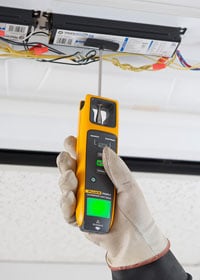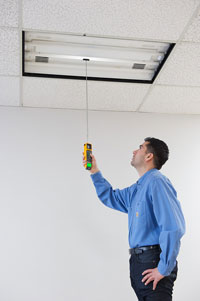We heard from a customer about efficiencies in testing light fixtures in a large commercial facility. Here's what he told us.
I'm responsible for all the electrical components at a sprawling 10,000-square-foot (.9-square-meter) hotel and retail facility in the Pacific Northwest.
"The lamp tester has made things quicker. It's saved time and I would say we've cut 40 to 60 minutes out of doing roughly 50 light fixtures a day."
That means responding to requests not only from building ownership, but also from the many tenants in the complex.
It's my job to make sure anything that needs attention gets taken care of right away. We are a first-class facility and we just can't let maintenance issues slide.

One of the biggest parts of my job is making sure that one of our site electricians, Jim, maintains all of the lighting systems. That includes keeping a numerous large ceiling-mounted fluorescent fixtures shining. In fact, lighting is his full-time job. Two other guys spend about 15 to 20 percent of their time on lighting.
When one of those tube lights go out, I hear about it.
For the electricians that usually means dragging out a ladder, then climbing up it to use an NCV detector to see if voltage is coming out of the ballast. But the NCV test isn't always reliable because it can only test the incoming voltage. So they usually end up just replacing the light—and if that doesn't fix the problem, replacing the ballast as well.
Recently we started using a Fluke 1000FLT Fluorescent Light Tester. It's been a real time saver.
Sometimes the electricians don't even need a ladder because of the telescoping metal extender.

I love the lamp tester because we don't have to remove lamps from the fixture and we can immediately find out if they are bad by performing the tests. I also really like the resistance test—aka pin test—to get continuity instead of having to pull out another meter. It saves me time and the electricians don't have to walk to the shop to get a replacement lamp.
The one thing to be aware of is: once you find out that the ballast is working and the lamp is good, you have to check the wiring for loose connections or a broken tombstone. Which you can't really do even with a meter so you have to visually inspect it to see if it's broken or it isn't making a good connection.
I'm always looking for opportunities to cut costs and time from our day. The lamp tester has made things quicker. It's saved time, and I would say we've cut 40 to 60 minutes out of doing roughly 50 light fixtures a day.